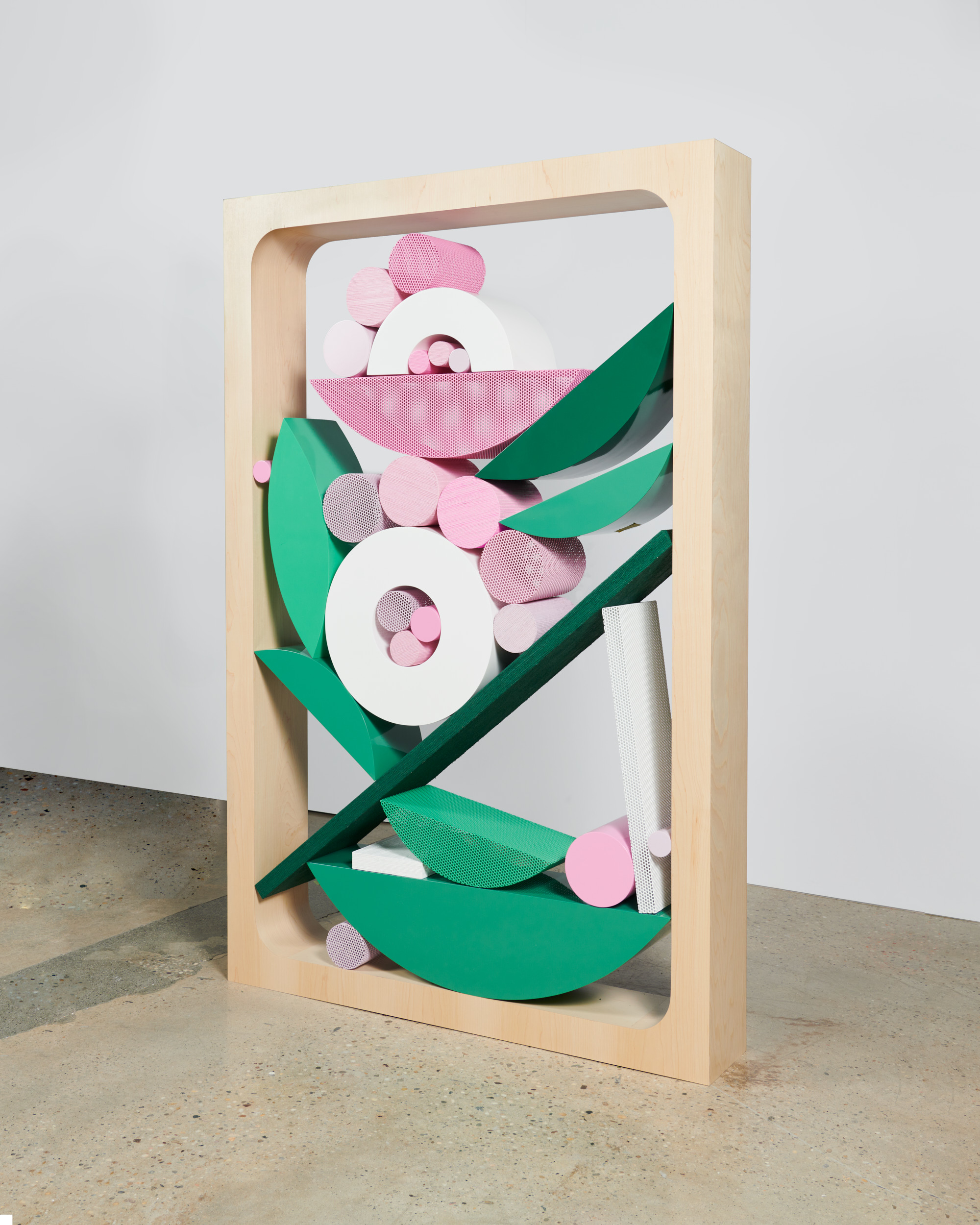
In February, Hermès unveiled “Flowers”, a series of three sculptures by the artist Chris Bogia in the windows of its Beverly Hills store. Framed in birch, the abstracted flora is also composed of perforated steel, grasscloth wallpaper, and lacquer. Added to the assemblage is an assortment of the French luxury brand’s goods, such as seersucker baby shoes, loafers, and a prerequisite iconic silk scarf.
Chris Bogia’s abstract floral sculptures, commissioned by Hermès. Courtesy of Hermès.
“I wanted to embrace beauty,” Bogia explains, “and let the surfaces tell the story alongside the sensuality of the handmade Hermès things.” This savoir-faire is one facet that links the heritage maison to the artist.
Bogia works solo, without assistants, and most aspects of his sculptures are created by hand. When not in his studio, he teaches sculpture at New York University (NYU). He says, “When I told my students I was doing this Hermès project, the level of respect that they had for me increased exponentially.” But how did the New York artist get on the luxury brand’s radar for the collaboration?
Bogia’s sculptures are on display until May at the Hermès Beverly Hills store. Courtesy of Hermès.
“Dude, they slid into my DMs,” Bogia says from his Bronx studio, “and it’s really been a pleasure cruise ever since!” The artwork is on display until May. It’s apropos that Hermès reached out via an app. The vivid commissions are refreshingly serene with just a touch of the haphazard and are part of a larger unnamed series. “The idea was to make something that’s the scale of furniture,” he explains, “and then with balanced intention, create a sculpture of an abstract painting within this bookcase physical frame.”
Although the sculptures look chicly Luddite, they are actually sly, aesthetically-pleasing responses to cell phone-saturated modernity. Notice the familiar shape of the frame? But Bogia isn’t necessarily making an anti-statement.
The artist Chris Bogia. Photo: Charlie Rubin
“We talk about the ‘doom scroll’ as if it’s the inevitable way of looking at your phone,” he says. “But actually, people experience art, beauty, and sensuality on those screens too—in abundance. It’s important to remember things can be beautiful.”
Bogia’s philosophy (and art practice) have evolved. After graduating from NYU, he earned an MFA in sculpture from Yale in 2004. In 2011, he co-founded the LGBTQ non-profit Fire Island Artist Residency.
”I was making work that was definitely front-loaded,” he says. “I felt a responsibility to express my queerness in my work as a young artist coming out of grad school. After running a nonprofit for ten years and really dedicating half my time to supporting queer artists, my practice became unburdened by the need to address that. I was able to explore the things that brought me the most pleasure and came the easiest, which to me is like working like an interior or fashion designer, if you will, and thinking about beauty in the form of colors, textures, and textiles. I was able to double down on those parts of my creativity.”
Chris Bogia, Big Bonsai (2019). Courtesy of the artist and Mrs., Maspeth, NY.
Bogia is now working on two private commissions and is greatly inspired by public projects. Last year, a 14-foot sculpture of a candle was well-received on the Provincetown waterfront, and a tour is now being developed for the piece. Candles are a recurring theme in his oeuvre and could be found dotting Bogia’s solo show at Mrs. gallery in Maspeth, Queens, last year. Currently, he’s developing a large-scale public work set to go on view in the Bronx next year.
“When you make something for someone who’s literally walking down the street, it’s a different set of priorities,” he explains. “I need to make sure that a person who didn’t go to art school and maybe doesn’t care about conceptual art can have a meaningful experience with work that is just as rich and layered and interesting. I think by embracing beauty in a traditional kind of way, you can bring more people into the work. If you dazzle someone, they’re dazzled.”
More Trending Stories:
Which A-List Art Power Couple Was Behind That Absurd, Now-Viral Ad for an Assistant? We Found Out